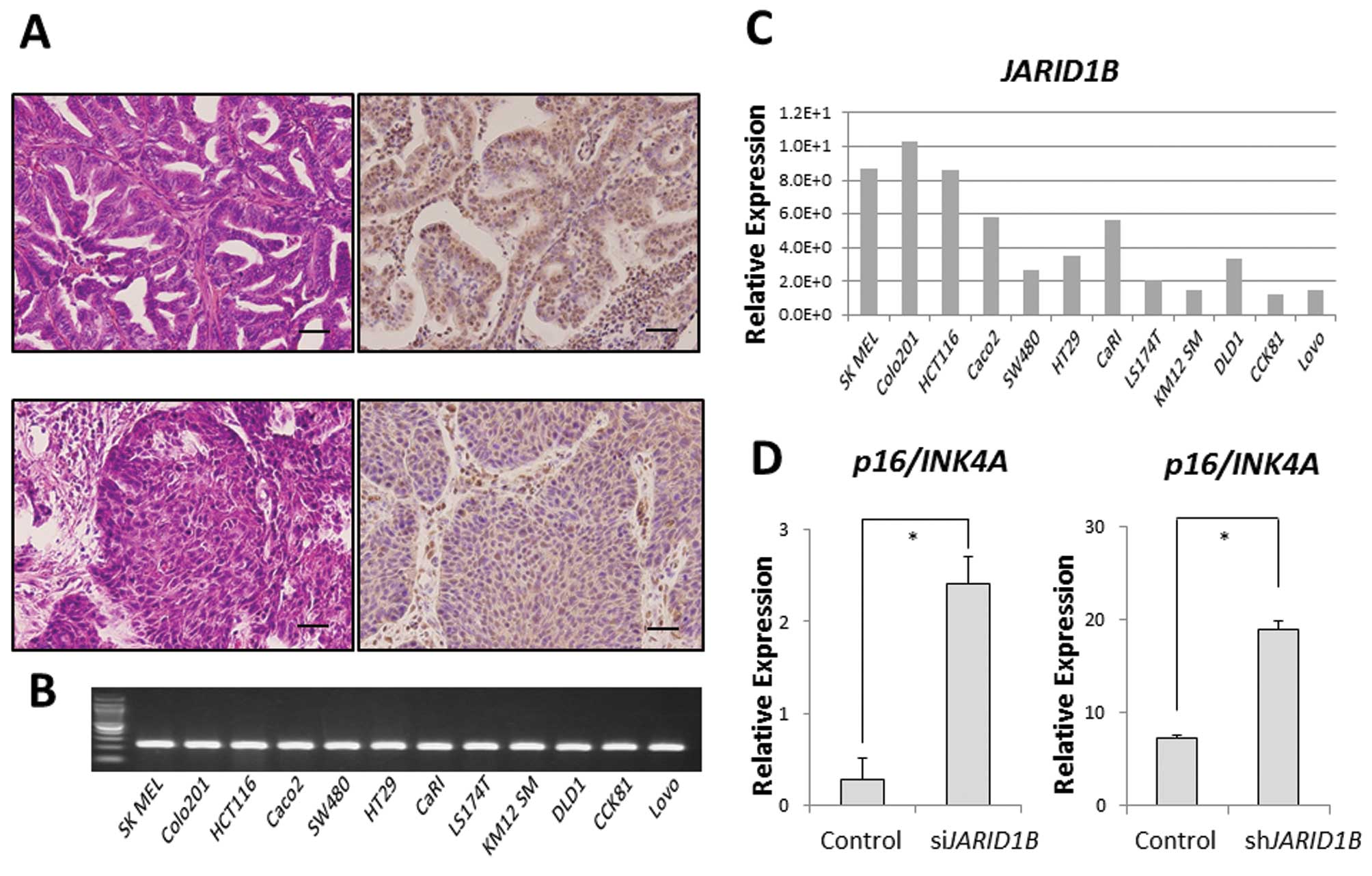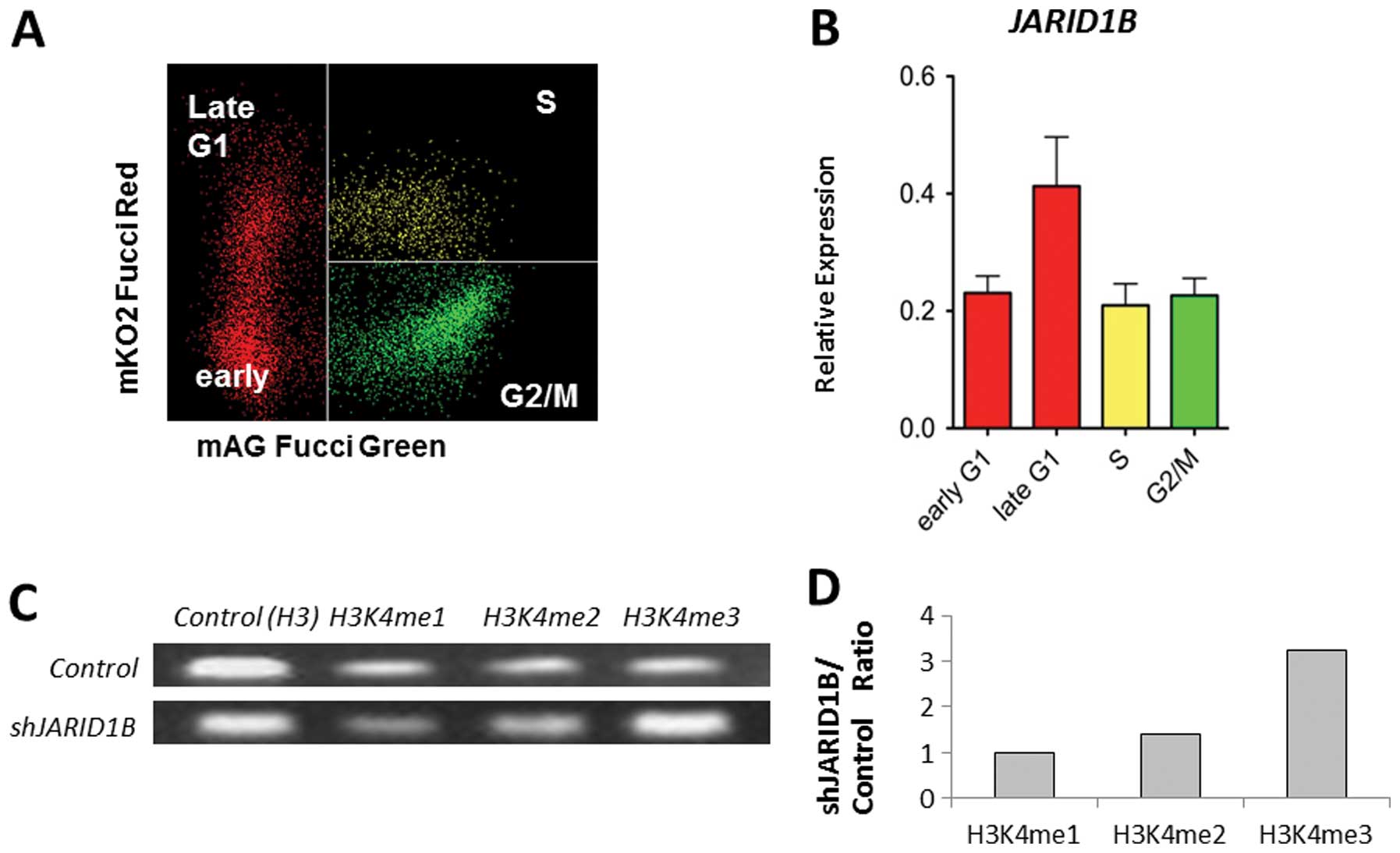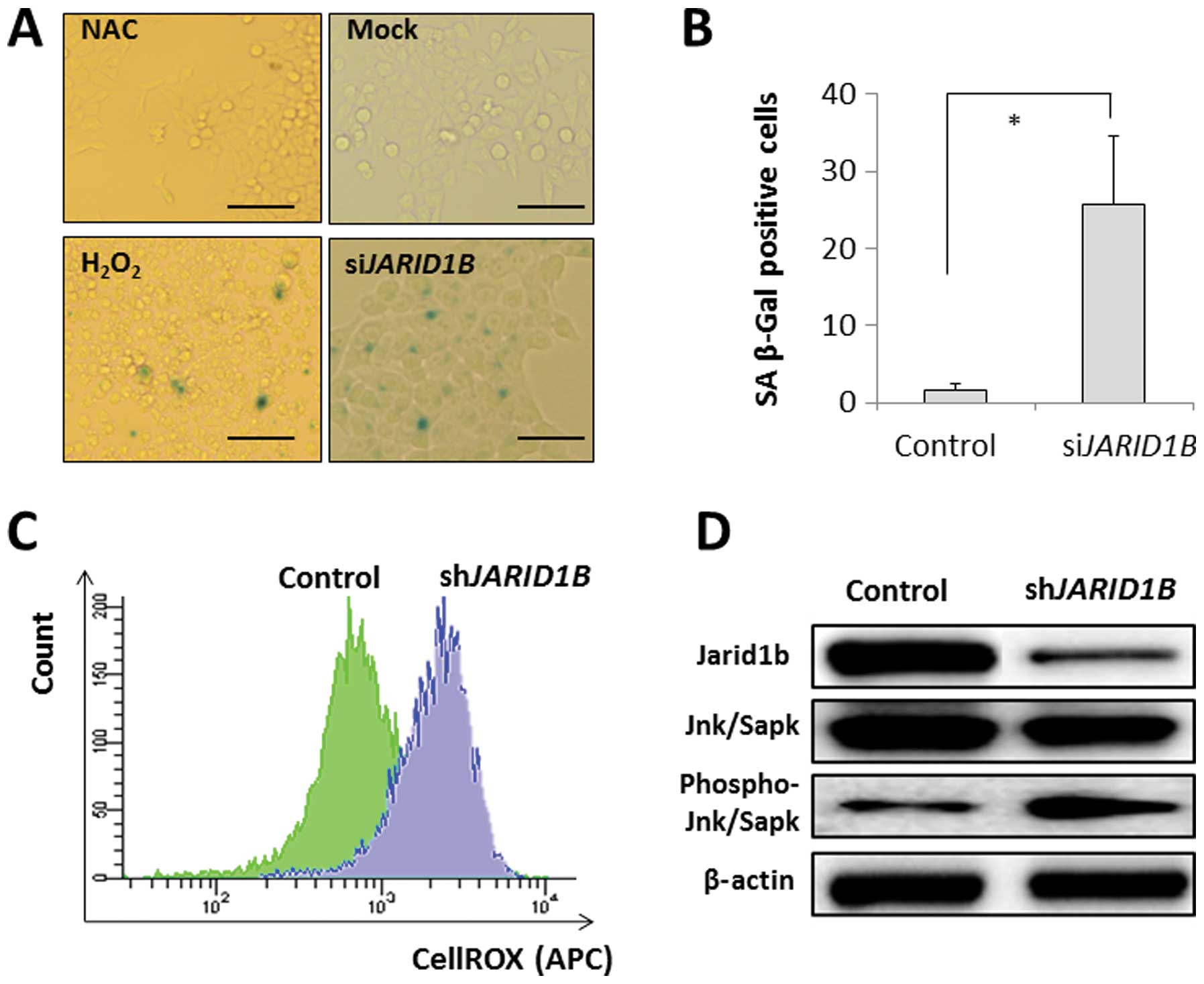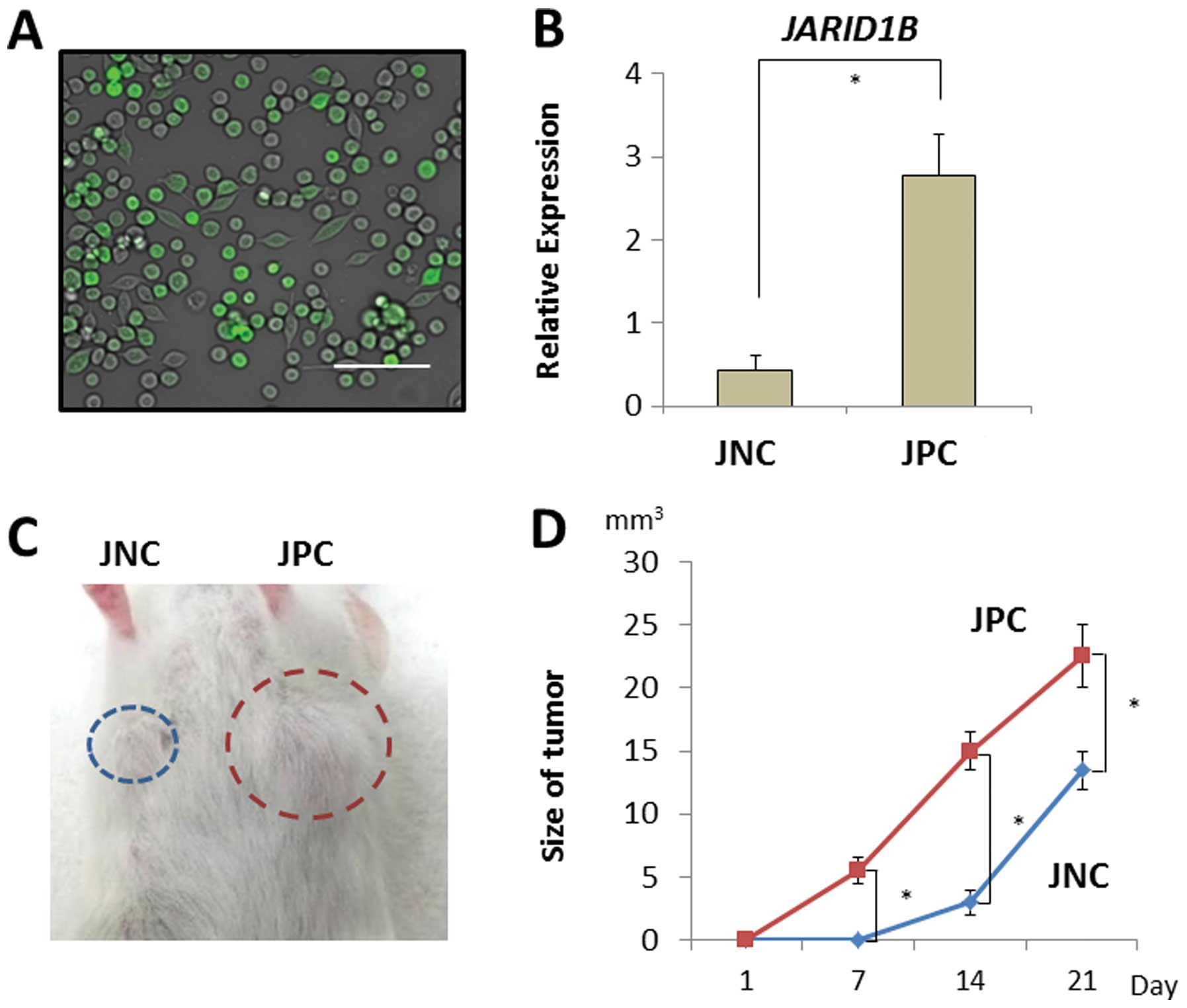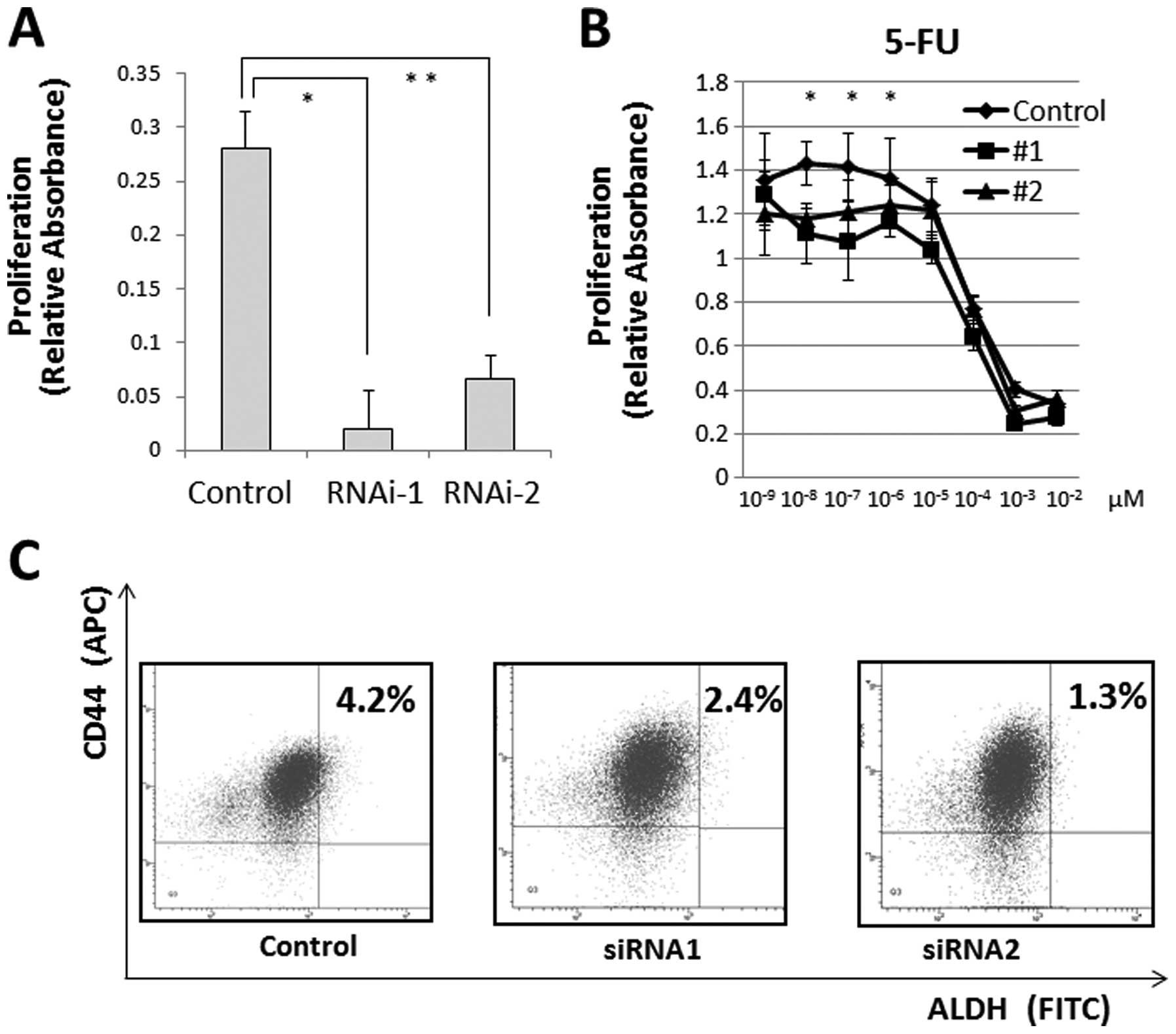Depletion of JARID1B induces cellular senescence in human colorectal cancer
- Authors:
- Published online on: January 25, 2013 https://doi.org/10.3892/ijo.2013.1799
- Pages: 1212-1218
Abstract
Introduction
Human colorectal cancer (CRC) is one of the most frequently diagnosed cancers in the Western world and a leading cause of mortality in the USA. Genetic events (mutations, deletions, genome amplifications and chromosome translocations) are involved in the initiation and progression of CRC and their stepwise accumulation is a driving force of malignancies (1). Epigenetic regulation also plays a critical role in the pathogenesis of CRC. DNA methylation is a component of the epigenetic gene-silencing complex (2), whereas histone (H3 and H4) post-translational modifications comprise a ubiquitous component of rapid epigenetic changes (3). Epigenetic changes are associated with altered transcription (4). Metastasis correlates with the loss of epithelial differentiation, induction of epithelial mesenchymal transition and the acquisition of a migratory phenotype, which are controlled by epigenetic alterations caused by the dysregulation of the transcriptome in CRC (4).
The basic nucleosome unit has four core histone proteins (H2A, H2B, H3 and H4). Histones H3 and H4 are generally associated with active gene transcription. Their acetylation levels are crucial with respect to the chromatin status and regulation of gene expression (5). Using the H3K4 demethylase, jumonji, AT rich interactive domain 1B (JARID1B), as a biomarker, a small subpopulation of tumor-initiating cells was isolated from a melanoma sample (6). JARID1B depletion has been shown to eliminate melanoma cell growth (6). Therefore, in this study, we investigated the effect of JARID1B depletion by lentiviral transfer of small hairpin RNA (shRNA) molecules on CRC cells. We identified a novel phenotype and cellular senescence in CRC induced by continuous JARID1B depletion, as well as tumor elimination and regression, which suggests a potential role for JARID1B in CRC diagnosis and therapy.
Materials and methods
Immunohistochemistry
Immunohistochemical staining was performed on 4-μm sections of formalin-fixed, paraffin-embedded surgical tumor samples. The sections were mounted, deparaffinized in xylene and rehydrated in descending concentrations of ethanol. Antigen retrieval was performed using citrate buffer (10 mM, pH 6.0) heated in a pressure cooker for 5 min. The blocking of endogenous peroxidases was accomplished by incubating the sections in 3% hydrogen peroxide (H2O2; Wako Pure Chemical Industries, Ltd.) for 5 min. The sections were incubated with rabbit anti-JARID1B antibody (1:100; Novus Biologicals) overnight at 4°C. Immunostaining for JARID1B was performed using the Envision + Dual Link System and Vectastain ABC kit (Vector Laboratories) according to the manufacturer’s instructions. The sections were counterstained with hematoxylin and eosin.
Cell culture
Three CRC cell lines (Colo201, DLD1 and HCT116) were used. Colo201 and DLD1 cells were cultured in RPMI-1640 supplemented with 10% fetal bovine serum (FBS). HCT116 and human embryonic kidney (HEK)-293T cells were cultured in Dulbecco’s modified Eagle’s medium (DMEM) supplemented with 10% FBS. Transfection was performed using FuGENE-6 (Roche) transfection reagent according to the manufacturer’s instructions, followed by lentiviral production in HEK-293T cells and viral infection (Roche).
Proliferation and MTT assays
Quantification of cell proliferation was based on measurements of bromodeoxyuridine (BrdU) incorporation during DNA synthesis in replicating (cycling) cells using the BrdU Cell Proliferation ELISA kit (colorimetric) (Roche). The cells (1.0×105) were incubated with 0–1×10−2μM 5-fluorouracil (5-FU; Kyowa Hakko Kirin Co., Ltd.) for 48 h and analyzed using the Cell Proliferation kit I (MTT; Roche).
Flow cytometry and cell sorting
Allophycocyanin (APC)-conjugated anti-human CD44 (BD Biosciences) and fluorescein isothiocyanate-conjugated anti-human aldehyde dehydrogenase (ALDH; the Aldefluor kit, Aldagen) were used to characterize cancer cells. Labeled cells (1×106) were analyzed using the BD FACSAria II cell sorter system (Becton-Dickinson), followed by data analysis using the Diva program (Becton-Dickinson). The fluorescent ubiquitination-based cell cycle indicator (Fucci)-G1 DsRed2 contains a fragment of human Cdt1 (amino acids 30–120), which is ubiquitinated by the ubiquitin ligase complex SCFskp2 during the S and G2 phases and degraded by proteasomes, thereby denoting the G1 phase (7). Fucci-S/G2/M Green contains a fragment of human geminin (amino acids 1–110) linked to enhanced green fluorescent protein (EGFP), which is ubiquitinated by the E3 ligase complex APCcdh1 and degraded by proteasomes during the M and G1 phases, denoting the S, G2 and M phases (7). DsRed2 and mKO2 or EGFP and mAG were excited by 488-nm laser lines and their emission was detected with 530/30BP and 585/42BP filters, respectively.
Reactive oxygen species (ROS) assay and senescence-associated (SA) β-galactosidase (SA-β-gal) analysis
The ROS assay was performed as described previously (8). To evaluate the effects of ROS, 10 μM N-acetyl cysteine (NAC; Wako Pure Chemical Industries, Ltd.), a general antioxidant and ROS inhibitor, was added. The cells (2×105) were treated with 20–100 μM H2O2 (Wako Pure Chemical Industries, Ltd.) for 1 h to induce oxidative stress. Intracellular ROS and SA-β-gal (the Senescence Detection kit) were analyzed using NAC (9). Intracellular ROS levels were determined by incubating the cells for 30 min at 37°C with 5 μM CellROX™ Deep Red reagent (Invitrogen Life Technologies) in complete medium, followed by cytometry.
Protein analysis
Western blot analysis and immunoprecipitation were performed. Total cell lysates were prepared using lysis buffer [50 mM 4-(2-hydroxyethyl)-1-piperazineethanesulfonic acid (HEPES) (pH 7.5), 150 mM NaCl, 1% TritonX-100] containing ethylenediaminetetraacetic acid (EDTA)-free protease inhibitors. Cell lysates containing 20 μg of protein were electrophoresed on TGX™ gels (Bio-Rad). Subsequently, proteins were transferred onto a PVDF membrane (Bio-Rad). The primary antibodies were JARID1B (1:2,000; Novus Biologicals), c-Jun N-terminal kinase (Jnk/Sapk; 1:1,000; Cell Signaling Technology, Danvers, MA), phospho-Jnk/Sapk (1:1,000; Cell Signaling Technology) and β-actin (loading control; 1:5,000; Cell Signaling Technology). Western blotting signals were detected and quantified by image analysis software (Multi Gauge version 3, Fujifilm). The means ± standard deviation (SD) of three independent experiments were determined.
Chromatin immunoprecipitation (ChIP) analysis
ChIP analysis was performed using the ChIP-IT Express Enzymatic kit (Active Motif, Carlsbad, CA). The antibodies used for ChIP analysis were histone H3 (ab1791, Abcam), H3K4 me3 (ab8580, Abcam), H3K4 me2 (ab32356, Abcam) and H3K4 me1 (ab8895, Abcam), with rabbit immunoglobulin G (IgG) (ab46540, Abcam) used as the negative control. Immunoprecipitated DNA (100 ng) was quantified by real-time quantitative PCR (qPCR) using the following primers: human p16/INK4A promoter, 5′-AACCGCTGCACGCCTCTGAC-3′ (forward) and 5′-CCGCGGCTGTCGTGAAGGTT-3′ (reverse). The means ± SD of three independent experiments were determined.
RNA interference (RNAi)
RNAi involved the transfection of small interfering RNA (siRNA) oligos (Cosmo Bio Co., Ltd) or infection with an shRNA-encoding lentivirus against JARID1B (NM_006618, Sigma-Aldrich) and a control (SHC002, Sigma-Aldrich). The target sequences were as follows: KDM5B #1 (100 μM), GAGCCAGAGGCCAUG AAUAUT (sense) and AUAUUCAUGGCCUCUGCUC (anti-sense), and KDM5B #2 (100 μM), GGGAACGAGUUAA GAAAAU (sense) and AUUUUUCUUAACUAGUUCCC (antisense). siRNA oligos were previously validated. siRNA duplexes were transfected into subconfluent cells using Lipo-fectamine RNAiMAX (Invitrogen Life Technologies). The shRNA target sequence was as follows: JARID1B, 5′-CCGGC CCACCAATTTGGAAGGCATTCTCGAGAATGCCTTCC AAATTGGTGGGTTTTT-3′.
Real-time reverse transcription PCR (qRT-PCR)
Real-time qRT-PCR was performed using a Light Cycler (Roche). Amplified signals were confirmed on the basis of the dissociation curves and normalized against glyceraldehyde-3-phosphate dehydrogenase (GAPDH). PCR primer sequences were as follows: human GAPDH, 5′-ATGTTCGTCATGGGTGTG AA-3′ (forward) and 5′-TGAGTCCTTCCACGATACCA-3′ (reverse); human JARID1B, 5′-CGACAAAGCCAAGAGTC TCC-3′ (forward) and 5′-GGATAGATCGGCCTCGTGTA-3′ (reverse); and human p16/INK4A, 5′-GTGTGCATGACGTGC GGG-3′ (forward) and 5′-GCAGTTCGAATCTGCACCG TAG-3′ (reverse). The means ± SD of three independent experiments were determined.
Animal experiments
Six-week-old female NOD/SCID mice were maintained in a pathogen-free environment. All procedures for animal studies were approved by the Institutional Ethical Committee of the Faculty of Medicine, Osaka University. 1×106 tumor cells (viability >90%) per 50 μl Matrigel (BD Biosciences) were injected subcutaneously. Tumor volume was measured by callipering the largest diameter (A) and its perpendicular (B), and calculated according to the NCI protocol [TV = (A × B2)/2].
Statistical analysis
Categorical variables were compared by the Chi-square test. Continuous variables (medians/interquartile ranges) were compared using the Wilcoxon test. Statistical analyses were performed using JMP software (JMP version 8.01, SAS Institute). P-values <0.05 were considered to indicate statistically significant differences.
Results
Ubiquitous JARID1B expression in clinical samples and various CRC cell lines
A number of studies have revealed the importance of the correlation between different types of cancer (melanoma, prostate and breast cancer) and epigenetic factors; however, to date, no study has suggested the existence of such a correlation for gastrointestinal cancer (6,10,11). JARID1B was ubiquitously expressed in some clinical samples of gastrointestinal cancer (modified differentiated adenocarcinoma, Fig. 1A). In addition, we also confirmed ubiquitous JARID1B expression in 11 CRC cell lines. Relative JARID1B expression in 11 colon adenocarcinoma cell lines and one melanoma cell line (SK MEL) as a positive control was assessed using qPCR (Fig. 1B) (6). Colo201 and HCT116 cells expressed higher JARID1B levels than DLD1 cells in vitro (Fig. 1C). In the Colo201 and HCT116 cells, the expression of the tumor suppressor, p16/INK4A, was increased in JARID1B-depleted cells compared with that in the control cells (Fig. 1D), suggesting that JARID1B and p16/INK4A expression is inversely correlated.
JARID1B controls p16/INK4A expression
JARID1B plays a role in the compaction of active chromatin, which impedes the access of transcription factors to genes and induces gene silencing (5). Thus, JARID1B expression may be associated with cell cycle progression. Fucci transfectants of CRC cells revealed that endogenous JARID1B expression increased in the late G1 phase (Fig. 2A and B), suggesting the association of JARID1B with p16/INK4A, which plays a critical role in the G1-S transition checkpoint (12,13). ChIP analysis indicated that compared with the control cells, multimethylated forms of H3K4 were preferentially associated with the promoter sequence of the p16/INK4A genes in JARID1B-depleted cells (Fig. 2C). JARID1B depletion led to the trimethylation of the p16/INK4A promoter (Fig. 2D). Thus, JARID1B may play a role in active chromatin compaction of the p16/INK4A promoter, which contributes to gene silencing. Therefore, JARID1B depletion may lead to p16/INK4A activation.
JARID1B depletion induces cellular senescence in CRC cells
p16/INK4A is associated with the SA phenotype, which occurs by the retinoblastoma-inhibiting action of cyclin-dependant kinases, leading to G1 cell cycle arrest (13–15), with the involvement of ROS (16). SA-β-gal activity was detected in the JARID1B-depleted CRC cells but not in the mock-transfected control cells (Fig. 3A and B). The effect of JARID1B depletion on SA-β-gal activity was similar to that of H2O2 exposure with an ROS inducer in the medium but not similar to that of the negative experimental control with NAC in the medium (Fig. 3A and B). This suggests that intracellular ROS may be involved in cellular senescence induction. The results from the present study illustrated that intracellular ROS levels were higher in JARID1B-depleted CRC cells than in mock-transfected control cells (Fig. 3C), which supports the involvement of ROS in senescence induction in JARID1B-depleted cells. Immunoblot analysis of SA phenotypes revealed the increased phosphorylation of Jnk/Sapk, an inducer of cellular senescence, in JARID1B-depleted cells; JARID1B expression was decreased by RNAi (Fig. 3D).
JARID1B depletion suppresses CRC growth
JARID1B depletion suppressed CRC cell growth in vitro by intracellular ROS accumulation and cellular senescence activation. Therefore, we investigated its effects on tumor growth in vivo. JARID1B-positive and -negative CRC cells were sorted using a fluorescent tracer vector controlled by the JARID1B promoter (Fig. 4A). CRC cells were separated on the basis of d2-Venus expression and the fluorescent intensity depended on the endogenous expression of the JARID1B promoter (Fig. 4B). JARID1B-positive and -negative CRC cells were subcutaneously inoculated into immunodeficient NOD/SCID mice to assess their tumorigenicity (Fig. 4C). Endogenous JARID1B-positive CRC cells produced substantial tumor growth compared with the JARID1B-negative cells (Fig. 4D).
JARID1B depletion suppresses therapy-resistant CRC cell growth
We measured cell proliferation following JARID1B depletion and observed that JARID1B depletion significantly suppressed cell proliferation (Fig. 5A) and cell invasion (data not shown). Hence, we determined the resistance of CRC cells to chemotherapy, a feature of JARID1B-depleted cells (17,18). The MTT assay illustrated that compared with the controls, continuous JARID1B depletion induced resistance to 5-FU in culture (Fig. 5B), suggesting that JARID1B depletion contributes to cancer stem cell (CSC) suppression. The depletion of endogenous JARID1B has been shown to suppress tumorigenicity and eliminate CSCs in melanomas (6). Thus, we inhibited endogenous JARID1B using shRNA and confirmed the CSC fraction. Depletion of endogenous JARID1B reduced the CD44+/ALDH+ CSC fraction, indicating that continuous endogenous JARID1B inhibition contributed to the eradication of CRC stem cells (Fig. 5C).
Discussion
Histone methylation/demethylation generally deactivates and activates genes by controlling the access of transcription factors to DNA. Histone dysregulation caused by genetic and epigenetic alterations is a hallmark of cancer (9,19). JARID1A/B-mediated histone H3K4 demethylation contributes to the silencing of retinoblastoma target genes in senescent cells, presumably by compacting chromatin and silencing certain genes (20). Distinct SA changes in histone-modification patterns are consistent with a repressive chromatin environment in the retinoblastoma tumor suppressor pathway (20). We found that JARID1B depletion, i.e., the inhibition of H3K4 demethylation, stimulated p16/INK4A transcription and suppressed tumor cell growth in vitro and in vivo, suggesting that it plays a role in cell growth regulation in human CRC (6).
The present findings are consistent with the notions that JARID1B depletion induces Jnk/Sapk-related senescence in CRC cells (21) and that endogenous JARID1B plays a role in controlling the cellular growth of CRCs. In cellular senescence, normal diploid cells lose the ability to divide. This anti-proliferative stress-response program acts as a potent tumor-suppressing mechanism (14,22). Growth-promoting and tumor suppressor genes are important factors controlling cancer cell proliferation. Cellular senescence can be triggered by a number of factors, including aging, DNA damage, oncogene activation and oxidative stress. Senescent cells have distinctive features, including stable cell cycle arrest and SA-β-gal activity. The tumor suppressor p16/INK4A plays a key role in regulating senescence induction, as may the tumor suppressor, p53. p16 acts through the retinoblastoma pathway to inhibit cyclin-dependant kinases, leading to G1 cell cycle arrest and senescence (14,23). Our results demonstrate that JARID1B plays a key role in CRC maintenance and that its continuous inhibition induces cellular senescence.
In the present study, we present a novel hypothesis that JARID1B suppression is an essential factor in cancer eradication. Although CSCs play a critical role in the survival, relapse and metastasis of malignant cancer cells (17), our data confirm the correlation between JARID1B suppression and CSCs. ALDH and CD44, a hyaluronic acid receptor, are considered useful markers of CRC stem cells (18). ALDH1A1 is responsible for CSC ALDH activity (24). It is known that CD44+/ALDH+ double-positive cells are CSC enrichment markers for reconstituted tumors in immunodeficient mice (18,24). In our study, endogenous JARID1B expression was lower in CD44+/ALDH+ cells than in CD44+/ALDH− or CD44−/ALDH− cells, suggesting that slowly proliferating JARID1B-expressing cells had a relatively undifferentiated phenotype that was compatible with that of CSCs (17,18). Our results demonstrate that JARID1B is involved in cell cycle regulation and that JARID1B facilitates cellular amplification and CSC maintenance. Future reports should further clarify the correlation between epigenetic factors and CSCs.
Therapeutic approaches to CRC include conventional therapies (surgical removal and chemoradiotherapy) and gene delivery strategies. For example, continuous JARID1B depletion could be achieved with antisense oligonucleotides or low-molecular-weight pharmacological therapeutics (25). A combination of p16/INK4A gene therapy and anti-JARID1B treatment may lead to the efficient induction of a SA phenotype in CRC cells.
Acknowledgements
We thank Dr Atsushi Miyawaki for providing us with the Fucci System plasmids. This study was partly supported by a Grant-in-Aid for Scientific Research from the Ministry of Education, Culture, Sports, Science and Technology (H.I. and M.M.); a Grant-in-Aid from the 3rd Comprehensive 10-year Strategy for Cancer Control, Ministry of Health, Labour and Welfare (H.I. and M.M.); a grant from the Kobayashi Cancer Research Foundation (H.I.); and a grant from the Princess Takamatsu Cancer Research Fund, Japan (H.I.). M.K., T.K., D.S., T.S. and H.I. were partially supported by Chugai Co., Ltd. and Yakult Honsha Co., Ltd. via institutional endowments.
References
|
Markowitz SD and Bertagnolli MM: Molecular origins of cancer: Molecular basis of colorectal cancer. N Engl J Med. 361:2449–2460. 2009. View Article : Google Scholar : PubMed/NCBI | |
|
Patai AV, Molnár B, Kalmár A, Schöller A, Tóth K and Tulassay Z: Role of DNA methylation in colorectal carcinogenesis. Dig Dis. 30:310–315. 2012. View Article : Google Scholar : PubMed/NCBI | |
|
Gargalionis AN, Piperi C, Adamopoulos C and Papavassiliou AG: Histone modifications as a pathogenic mechanism of colorectal tumorigenesis. Int J Biochem Cell Biol. 44:1276–1289. 2012. View Article : Google Scholar : PubMed/NCBI | |
|
Brabletz T, Jung A, Spaderna S, Hlubek F and Kirchner T: Opinion: migrating cancer stem cells-an integrated concept of malignant tumour progression. Nat Rev Cancer. 5:744–749. 2005. View Article : Google Scholar : PubMed/NCBI | |
|
Kouzarides T: Chromatin modifications and their function. Cell. 128:693–705. 2007. View Article : Google Scholar : PubMed/NCBI | |
|
Roesch A, Fukunaga-Kalabis M, Schmidt EC, et al: A temporarily distinct subpopulation of slow-cycling melanoma cells is required for continuous tumor growth. Cell. 141:583–594. 2010. View Article : Google Scholar : PubMed/NCBI | |
|
Sakaue-Sawano A, Kurokawa H, Morimura T, et al: Visualizing spatiotemporal dynamics of multicellular cell-cycle progression. Cell. 132:487–498. 2008. View Article : Google Scholar : PubMed/NCBI | |
|
Haraguchi N, Ishii H, Mimori K, et al: CD13 is a therapeutic target in human liver cancer stem cells. J Clin Invest. 120:3326–3339. 2010. View Article : Google Scholar : PubMed/NCBI | |
|
Takahashi A, Imai Y, Yamakoshi K, et al: DNA damage signaling triggers degradation of histone methyltransferases through APC/C(Cdh1) in senescent cells. Mol Cell. 45:123–131. 2012. View Article : Google Scholar : PubMed/NCBI | |
|
Yamane K, Tateishi K, Klose RJ, et al: PLU-1 is an H3K4 demethylase involved in transcriptional repression and breast cancer cell proliferation. Mol Cell. 25:801–812. 2007. View Article : Google Scholar : PubMed/NCBI | |
|
Xiang Y, Zhu Z, Han G, et al: JARID1B is a histone H3 lysine 4 demethylase up-regulated in prostate cancer. Proc Natl Acad Sci USA. 104:19226–19231. 2007. View Article : Google Scholar : PubMed/NCBI | |
|
Kastan MB and Bartek J: Cell-cycle checkpoints and cancer. Nature. 432:316–323. 2004. View Article : Google Scholar : PubMed/NCBI | |
|
Ohtani N, Zebedee Z, Huot TJ, et al: Opposing effects of Ets and Id proteins on p16INK4a expression during cellular senescence. Nature. 409:1067–1070. 2001. View Article : Google Scholar : PubMed/NCBI | |
|
Rayess H, Wang MB and Srivatsan ES: Cellular senescence and tumor suppressor gene p16. Int J Cancer. 130:1715–1725. 2012. View Article : Google Scholar : PubMed/NCBI | |
|
Zhang X, Wu X, Tang W and Luo Y: Loss of p16(Ink4a) function rescues cellular senescence induced by telomere dysfunction. Int J Mol Sci. 13:5866–5877. 2012. View Article : Google Scholar : PubMed/NCBI | |
|
Vurusaner B, Poli G and Basaga H: Tumor suppressor genes and ROS: complex networks of interactions. Free Radic Biol Med. 52:7–18. 2012. View Article : Google Scholar : PubMed/NCBI | |
|
Reya T, Morrison SJ, Clarke MF and Weissman IL: Stem cells, cancer and cancer stem cells. Nature. 414:105–111. 2001. View Article : Google Scholar : PubMed/NCBI | |
|
Dewi DL, Ishii H, Kano Y, et al: Cancer stem cell theory in gastrointestinal malignancies: recent progress and upcoming challenges. J Gastroenterol. 46:1145–1157. 2011. View Article : Google Scholar : PubMed/NCBI | |
|
Hanahan D and Weinberg RA: Hallmarks of cancer: the next generation. Cell. 144:646–674. 2011. View Article : Google Scholar : PubMed/NCBI | |
|
Chicas A, Kapoor A, Wang X, et al: H3K4 demethylation by Jarid1a and Jarid1b contributes to retinoblastoma-mediated gene silencing during cellular senescence. Proc Natl Acad Sci USA. 109:8971–8976. 2012. View Article : Google Scholar : PubMed/NCBI | |
|
Maruyama J, Naguro I, Takeda K and Ichijo H: Stress-activated MAP kinase cascades in cellular senescence. Curr Med Chem. 16:1229–1235. 2009. View Article : Google Scholar : PubMed/NCBI | |
|
Rodier F and Campisi J: Four faces of cellular senescence. J Cell Biol. 192:547–556. 2011. View Article : Google Scholar : PubMed/NCBI | |
|
Ohtani N, Mann DJ and Hara E: Cellular senescence: its role in tumor suppression and aging. Cancer Sci. 100:792–797. 2009. View Article : Google Scholar : PubMed/NCBI | |
|
Marcato P, Dean CA, Giacomantonio CA and Lee PW: Aldehyde dehydrogenase: its role as a cancer stem cell marker comes down to the specific isoform. Cell Cycle. 10:1378–1384. 2011. View Article : Google Scholar : PubMed/NCBI | |
|
Yamamoto T, Nakatani M, Narukawa K and Obika S: Antisense drug discovery and development. Future Med Chem. 3:339–365. 2011. View Article : Google Scholar |



